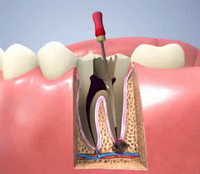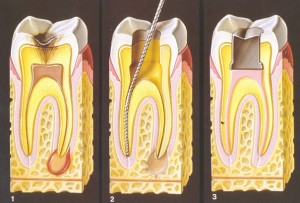Toothpulpation before prosthetics

When installing dentures, tooth preparation is very often carried out.
Preparation includes tooth turning under the crowns and nerve removal.
Before installing a dental crown, tooth enamel and tooth tissue are removed to the thickness of the future crown.
In some cases, tooth deculpation before prosthetics is necessary.
At the same time, whether or not to remove the tooth during prosthetics, in each individual case, the doctor decides.
It cannot be determined in advance whether dental nerve removal is necessary.
If the patient, after depulpation, complains of painful sensations, it is necessary to wait until the pain disappears and only then do prosthetics.
Why is pulp removal performed?
- To prevent further development of pulpitis, a nerve is removed before prosthetics and the cavity is filled with filling material.
- In the absence of pulp, tooth enamel loses its natural color and luster, and also becomes more susceptible to the harmful effects of environmental factors.
- Over time, tooth decay occurs.
Does nerve always need to be removed
In recent years, the question: whether to pulp a tooth before prosthetics is controversial among dentists.
The fact is that removing the nerve before installing the prosthesis very often causes many complications.
Complications
- Incomplete nerve removal.
- Going beyond the top of the tooth, which leads to the occurrence of periodontitis and granulomas.
Indications
Depulpation is not a mandatory procedure before performing a prosthesis.
There are certain indications:

- Anatomically incorrect position of the tooth.
- Deep and advanced tooth decay.
- The presence of root caries or several tooth roots.
- Low crowns.
- The inability to process the tooth without opening the pulp chamber.
- Anatomical features of the tooth: large size pulp chamber, a large inclination of the axis of the tooth.
- The inflammatory process of the pulp or periodontal.
In other cases, the issue of depulpation should be decided individually, taking into account the condition of the prosthetics, the age of the patient and the anatomical features of the teeth.
Especially careful consideration is required for healthy teeth, which perform the function of supporting teeth during prosthetics with bridge structures.
Thus, on the basis of the concept of modern dentistry, tooth removal is a gross violation, in the absence of indications to it.
The installation of a tooth crown is not an indication for nerve removal; rather, the presence of a tooth with pulp removed is an indication for prosthetics with a dental crown.
In order to avoid complications during depulpation, it is necessary to use the most modern technologies.
How is
Carrying out depulpation involves the use of modern technologies: local anesthesia, which eliminates pain during nerve removal, as well as airborne cooling, which eliminates overheating of tooth tissues.
Depilation is carried out in two stages.
First stage:
- Anesthesia
- The exposure of the root canal, the removal of pulp and soft tissues.
- Temporary root canal filling.
Second phase:
- Canal filling with permanent filling.
- Final restoration of the tooth crown using filling material.
Video: “Preparation with a ledge for a ceramic crown”
Pain in a pulp tooth
Often patients complain of pain in a tooth that has a nerve removed. This phenomenon is not as rare as it might seem. In this case, an X-ray examination is required and, in the presence of complications, urgent treatment.
The causes of pain in the tooth after its depulpation:

- A specific reaction of the body to the nerve removal procedure and root canal filling.
- Poorly cleaned or sealed channels.
- Not all nerves have been removed.
- Use of inappropriate filling material.
- Inflammation of the gums resulting from tissue injury during tooth treatment.
- The presence of pain in the adjacent tooth, giving back to the tooth with pulp removed.
What to do
Seek medical advice immediately.
- If the cause of the pain is the reaction of the body to root canal filling, an anti-inflammatory treatment is prescribed.
- If the pain is associated with a poorly performed procedure, the treatment process will drag on for a long time and will be difficult.
Previously, in the presence of pain in a tooth with pulp removed, it was removed.
Modern methods make it possible to unseal and further treat the canals.
Perhaps the use of other methods of treatment.
Teeth life
The life of a depulped tooth depends on the qualifications and experience of the dentist who performed the procedure.
If all the channels were thoroughly cleaned, disinfected and hermetically sealed, then such a tooth will serve its master for many years and even a lifetime.
It is advisable to install a ceramic crown on such a tooth.
Cost
The cost of tooth removal includes: anesthesia, pulp removal, root canal filling with temporary and permanent fillings.
Prices for services depend on the status of the dental clinic and may vary from one clinic to another.
| Service | Prices (RUB) |
| Pulp removal and extirpation from canals | 300 |
| Removal of pulp decay from the root canal | 400 |
| Endodontic processing: 1 channel | 700 |
| Two channels | 1200 |
| Three channels | 1500 |
| Four channels | 1700 |
| Canal filling: 1 channel | 700 |
| Two channels | 900 |
| Three channels | 1100 |
| Four channels | 1250 |
| Setting a temporary seal in 1 channel | 400 |
| In 2 channels | 600 |
| In 3 channels | 850 |
| In 4 channels | 1000 |
| Permanent seal installation | from 400 |